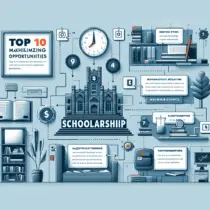In today’s fast-paced world, education has found new pathways beyond the traditional classroom setting. Online learning has become an essential part of higher education, allowing students to study from anywhere with an internet connection. This flexibility means that individuals can pursue their academic goals while balancing work, family, and other commitments. An important aspect of this educational journey is funding, and scholarships play a crucial role in helping students manage tuition costs.
The University of the People offers the best scholarship for online students in 2025. They provide full tuition support, making it possible for students from around the world to earn accredited degrees entirely online without the burden of tuition fees. This scholarship is ideal for those who need flexibility in their education while still receiving a quality academic experience. The University of the People’s commitment to accessible education makes it a top choice for online students seeking financial assistance.
As we approach 2025, several scholarship opportunities specifically cater to online learners. These scholarships aim to support students who choose virtual classrooms over brick-and-mortar institutions. Below is a comprehensive guide to some of the best scholarships available for online students in 2025.
1. The eLearners Scholarship Fund
The eLearners Scholarship Fund is designed to help online students achieve their academic dreams without financial burden. This scholarship offers $1,000 awards to multiple recipients each year.
Eligibility Requirements:
- Must be enrolled in an accredited online degree program.
- Must have a minimum GPA of 2.5.
- Must submit a personal essay detailing educational goals and financial need.
2. Get Educated Online College Scholarship
Get Educated provides a scholarship focused on assisting distance learning students who face financial challenges. The scholarship awards $1,000 twice annually.
Eligibility Requirements:
- Must be enrolled in an accredited online program.
- Must have completed at least 12 credit hours of coursework.
- Must demonstrate strong academic performance and financial need.
3. Study.com Academic Scholarships for Online Programs
Study.com offers several scholarships tailored specifically for various fields of study pursued through online programs. Each scholarship ranges from $500 to $1,000.
Eligibility Requirements:
- Must be enrolled or planning to enroll in an accredited online degree or certificate program.
- Different scholarships have specific eligibility criteria based on fields such as business, education, healthcare, etc.
- Must provide proof of enrollment and submit a short video or essay on why they chose their field of study.
4. College Raptor Scholarship
The College Raptor Scholarship helps ease the financial load for both traditional and non-traditional students pursuing higher education through online platforms by awarding up to $2,500 yearly.
Eligibility Requirements:
- Open to all U.S.-based college students including those attending fully-online schools.
- Applicants must complete a brief questionnaire about their educational plans and college search process.
- Winners are selected based on creativity and thoughtfulness demonstrated in their responses.
5. University Professional & Continuing Education Association (UPCEA) Scholarships
The UPCEA offers multiple scholarships specifically for adult learners pursuing education through non-traditional means such as online programs.
Eligibility Requirements:
- Enrolled in an accredited institution that is a UPCEA member.
- Demonstrate commitment towards completing their degree despite personal or professional obstacles.
- Provide letters of recommendation and personal essays outlining goals and challenges faced as an adult learner.
6. Imagine America Foundation Adult Skills Education Program (ASEP)
Imagine America Foundation provides assistance through ASEP which is aimed at adult learners who choose career-oriented programs delivered via online platforms.
Eligibility Requirements:
- Applicants must be at least 19 years old.
- Enrolled in participating colleges offering career-oriented programs available online.
- Demonstrate financial need along with dedication towards finishing the chosen program successfully with reasonable grades.
7. University Grants Commission (UGC) Scholarships for Distance Learning Students
Internationally recognized institutions also offer substantial support like UGC which funds distance learning students especially from developing regions striving towards global standards education accessible digitally across borders worldwide today!
Eligibility Criteria:
- Enrollment into any recognized international university providing certified courses/modules/programs remotely accessible wherever located globally
- Proof Financial Inability Supporting Required Tuition/Examination Fees Alongside Motivation Letter Outlining Purpose Behind Opting For Said Curriculum And Future Ambitions Post Completion thereof
8. FastWeb ‘Do Over’ Scholarship Contest Specific Towards Recovering From Previous Setbacks/Failures Restart Afresh Educationally Virtually Accessible Format Available Globally
FastWeb caters specifically towards those individuals keen restarting afresh educationally post encountering setbacks/failures previously still determined showcasing resilience overcoming adversity via this unique contest structured format designed globally accessible virtually aligning today’s digitized blended hybrid module:
**Pre-Requisites Ensuring Eligibility Attainment Successfully Include Amongst Others:
- Proof Encountering Personal Setbacks/Failures Preventing Continuation Traditional Form Education Previously Attempted However Determined Rectifying Course Pursuing Further Virtually Accessible Format Avoiding Repetition Similar Mistakes Learning Lessons Derived Experiences Nonetheless Remaining Focused Long-Term Objectives Fully Committed Success*
These listed offerings represent just some ways innovative approaches accessing quality affordable digitalized curriculum reachable irrespective physical constraints geographical boundaries otherwise hindering traditional paradigms education hitherto fore seen rigid evolving suitably needs demands contemporary times facilitating holistic inclusive community development uplifting socio-economic status particularly marginalized underprivileged sections society benefiting immensely thereby enabling emergence globally equitable sustainable progressive future envisioned collectively bridging existing divides ensuring opportunities equal accessible all deserving alike equitably empowered harness fullest potential therein transformed realities!






